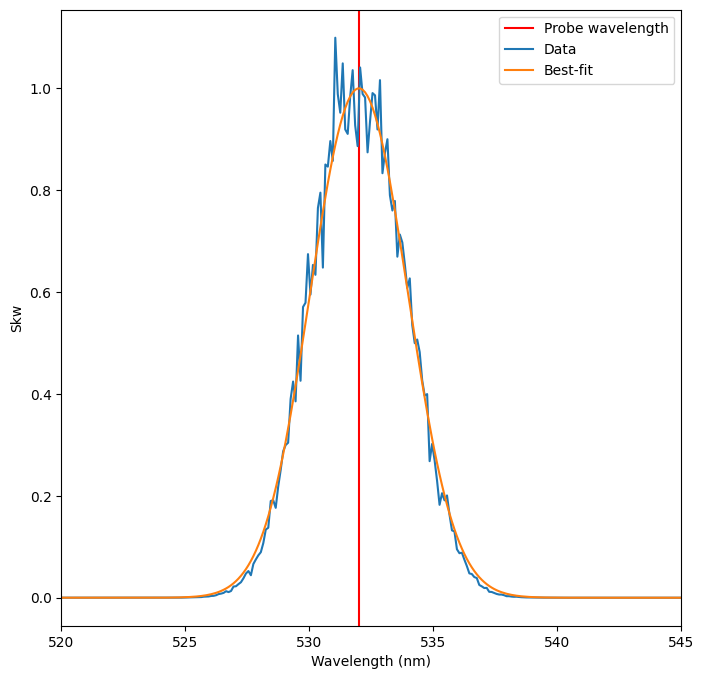This page was generated by
nbsphinx from
docs/notebooks/diagnostics/thomson_fitting.ipynb.
Interactive online version:
.
Fitting Thomson Scattering Spectra
Thomson scattering diagnostics record a scattered power spectrum that encodes information about the electron and ion density, temperatures, and flow velocities. This information can be retrieved by fitting the measured spectrum with the theoretical spectral density (spectral_density). This notebook demonstrates how to use the lmfit package (along with some helpful PlasmaPy functions) to fit 1D Thomson scattering spectra.
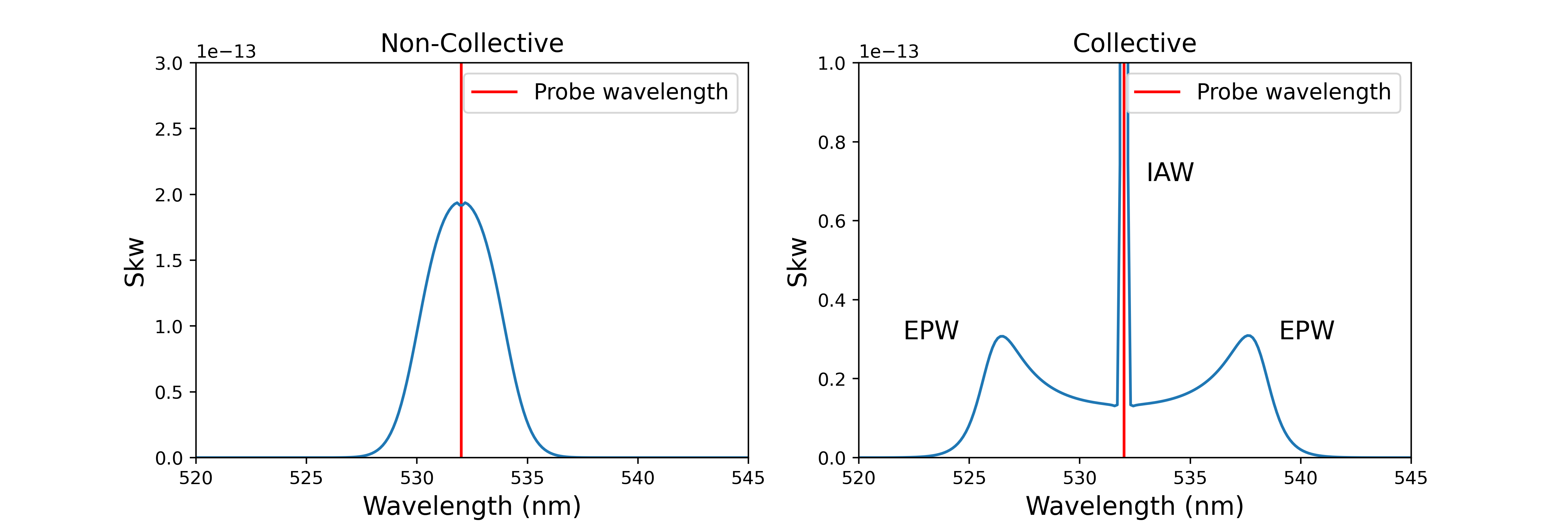
Thomson scattering can be either non-collective (dominated by single electron scattering) or collective (dominated by scattering off of electron plasma waves (EPW) and ion acoustic waves (IAW). In the non-collective regime, the scattering spectrum contains a single peak. However, in the collective regime the spectrum contains separate features caused by the electron and ion populations (corresponding to separate scattering off of EPW and IAW). These features exist on different scales: the EPW feature is dim but covers a wide wavelength range, while the IAW feature is bright but narrow. They also encode partially-degenerate information (e.g., the flow velocities of the electrons and ions respectively). The two features are therefore often recorded on separate spectrometers and are fit separately.
[1]:
%matplotlib inline
import astropy.units as u
import matplotlib.pyplot as plt
import numpy as np
from lmfit import Parameters
from plasmapy.diagnostics import thomson
Contents
Fitting Collective Thomson Scattering
To demonstrate the fitting capabilities, we’ll first generate some synthetic Thomson data using the spectral_density function. This data will be in the collective regime, so we will generate two datasets (using the same plasma parameters and probe geometry) that correspond to the EPW and IAW features. For more details on the spectral density function, see the spectral density function example notebook.
[2]:
# Generate theoretical spectrum
probe_wavelength = 532 * u.nm
epw_wavelengths = (
np.linspace(probe_wavelength.value - 30, probe_wavelength.value + 30, num=500)
* u.nm
)
iaw_wavelengths = (
np.linspace(probe_wavelength.value - 3, probe_wavelength.value + 3, num=500) * u.nm
)
probe_vec = np.array([1, 0, 0])
scattering_angle = np.deg2rad(63)
scatter_vec = np.array([np.cos(scattering_angle), np.sin(scattering_angle), 0])
n = 2e17 * u.cm**-3
ions = ["H+", "C-12 5+"]
T_e = 10 * u.eV
T_i = np.array([20, 50]) * u.eV
electron_vel = np.array([[0, 0, 0]]) * u.km / u.s
ion_vel = np.array([[0, 0, 0], [200, 0, 0]]) * u.km / u.s
ifract = [0.3, 0.7]
alpha, epw_skw = thomson.spectral_density(
epw_wavelengths,
probe_wavelength,
n,
T_e=T_e,
T_i=T_i,
ions=ions,
ifract=ifract,
electron_vel=electron_vel,
ion_vel=ion_vel,
probe_vec=probe_vec,
scatter_vec=scatter_vec,
)
alpha, iaw_skw = thomson.spectral_density(
iaw_wavelengths,
probe_wavelength,
n,
T_e=T_e,
T_i=T_i,
ions=ions,
ifract=ifract,
electron_vel=electron_vel,
ion_vel=ion_vel,
probe_vec=probe_vec,
scatter_vec=scatter_vec,
)
# PLOTTING
fig, ax = plt.subplots(ncols=2, figsize=(12, 4))
fig.subplots_adjust(wspace=0.2)
for a in ax:
a.set_xlabel("Wavelength (nm)")
a.set_ylabel("Skw")
a.axvline(x=probe_wavelength.value, color="red", label="Probe wavelength")
ax[0].set_xlim(520, 545)
ax[0].set_ylim(0, 3e-13)
ax[0].set_title("Electron Plasma Wave")
ax[0].plot(epw_wavelengths.value, epw_skw)
ax[0].legend()
ax[1].set_xlim(530, 534)
ax[1].set_title("Ion Acoustic Wave")
ax[1].plot(iaw_wavelengths.value, iaw_skw)
ax[1].legend();
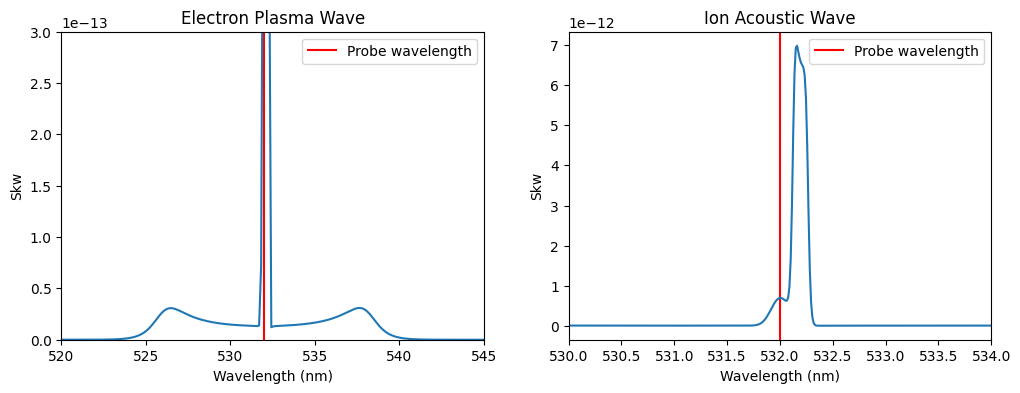
Note that these plots are showing the same spectral distribution, just over different wavelength ranges: the large peak in the center of the EPW spectrum is the IAW spectrum. Next we’ll add some noise to the spectra to simulate an experimental measurement.
[3]:
epw_skw *= 1 + np.random.normal(loc=0, scale=0.1, size=epw_wavelengths.size)
iaw_skw *= 1 + np.random.normal(loc=0, scale=0.1, size=iaw_wavelengths.size)
During experiments, the IAW feature is typically blocked on the EPW detector using a notch filter to prevent it from saturating the measurement. We’ll mimic this by setting the center of the EPW spectrum to np.nan. The fitting algorithm applied later will recognize these values and not include them in the fit.
The more of the EPW spectrum we exclude, the less sensitive the fit will become. So, we want to block as little as possible while still obscuring the IAW feature.
[4]:
Another option is to delete the missing data from both the data vector and the corresponding wavelengths vector.
epw_skw = np.delete(epw_skw, slice(x0,x1,None))
epw_wavelengths = np.delete(epw_wavelengths, slice(x0,x1,None))
This does not look as nice on plots (since it leaves a line between datapoints at x0 and x1) but is necessary in some cases (e.g. when also using an instrument function).
Finally, we need to get rid of the units and normalize the data on each detector to its maximum value (this is a requirement of the fitting algorithm). We’re using np.nanmax() here to ignore the NaN values in epw_skw.
[5]:
epw_skw = epw_skw.value
epw_skw *= 1 / np.nanmax(epw_skw)
iaw_skw = iaw_skw.value
iaw_skw *= 1 / np.nanmax(iaw_skw)
# Plot again
fig, ax = plt.subplots(ncols=2, figsize=(12, 4))
fig.subplots_adjust(wspace=0.2)
for a in ax:
a.set_xlabel("Wavelength (nm)")
a.set_ylabel("Skw")
a.axvline(x=probe_wavelength.value, color="red", label="Probe wavelength")
ax[0].set_xlim(520, 545)
ax[0].set_title("Electron Plasma Wave")
ax[0].plot(epw_wavelengths.value, epw_skw)
ax[0].legend()
ax[1].set_xlim(531, 533)
ax[1].set_title("Ion Acoustic Wave")
ax[1].plot(iaw_wavelengths.value, iaw_skw)
ax[1].legend();
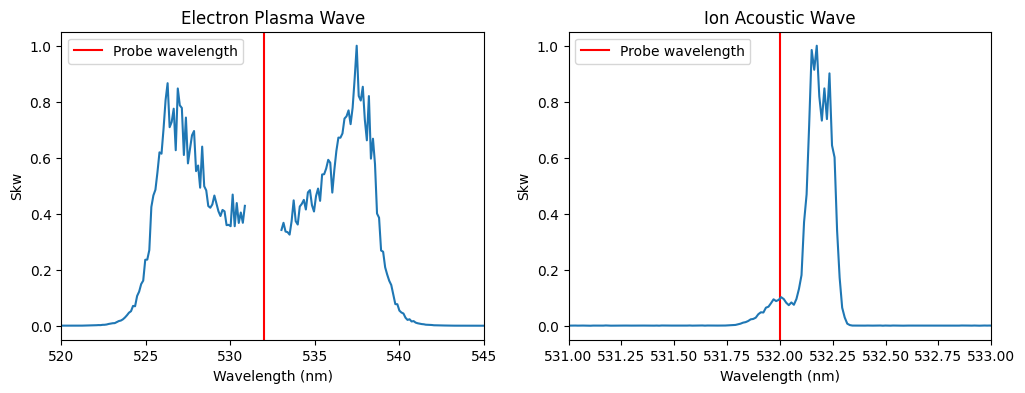
We’ll start by fitting the EPW feature, then move on to the IAW feature. This is typically the process followed when analyzing experimental data, since the EPW feature depends on fewer parameters.
Fitting the EPW Feature
In order to fit this data in lmfit we need to create an lmfit.Model object for this problem. PlasmaPy includes such a model function for fitting Thomson scattering spectra, spectral_density_model. This model function is initialized by providing the parameters of the fit in the form of an lmfit.Parameters object.
A lmfit.Parameters object is an ordered dictionary of lmfit.Parameter objects. Each lmfit.Parameter has a number of elements, the most important of which for our purposes are - “name” (str) -> The name of the parameter (and the key in Parameters
dictionary) - “value” (float) -> The initial value of the parameter. - “vary” (boolean) -> Whether or not the parameter will be varied during fitting. - “min”, “max” (float) -> The minimum and maximum bounds for the parameter during fitting.
Since lmfit.Parameter objects can only be scalars, arrays of multiple quantities must be broken apart into separate Parameter objects. To do so, this fitting routine adopts the following convention:
T_e = [1,2] -> "T_e_0"=1, "T_e_1" = 2
Specifying large arrays (like velocity vectors for multiple ion species) is clearly tedious in this format, and specifying non-numeric values (such as ions) is impossible. Therefore, this routine also takes a settings dictionary as a way to pass non-varying input to the spectral_density_model function.
A list of required and optional parameters and settings is provided in the docstring for the spectral_density_model function. For example:
Help on function spectral_density_model in module plasmapy.diagnostics.thomson:
spectral_density_model(wavelengths, settings, params)
Returns a `lmfit.model.Model` function for Thomson spectral density
function.
Parameters
----------
wavelengths : numpy.ndarray
Wavelength array, in meters.
settings : dict
A dictionary of non-variable inputs to the spectral density
function which must include the following keys:
- ``"probe_wavelength"``: Probe wavelength in meters
- ``"probe_vec"`` : (3,) unit vector in the probe direction
- ``"scatter_vec"``: (3,) unit vector in the scattering
direction
- ``"ions"`` : list of particle strings,
`~plasmapy.particles.particle_class.Particle` objects, or a
`~plasmapy.particles.particle_collections.ParticleList`
describing each ion species. All ions must be positive.
and may contain the following optional variables:
- ``"electron_vdir"`` : (e#, 3) array of electron velocity unit
vectors
- ``"ion_vdir"`` : (e#, 3) array of ion velocity unit vectors
- ``"instr_func"`` : A function that takes a wavelength
|Quantity| array and returns a spectrometer instrument
function as an `~numpy.ndarray`.
- ``"notch"`` : A wavelength range or array of multiple wavelength
ranges over which the spectral density is set to 0.
These quantities cannot be varied during the fit.
params : `~lmfit.parameter.Parameters` object
A `~lmfit.parameter.Parameters` object that must contain the
following variables:
- n: Total combined density of the electron populations in
m\ :sup:`-3`
- :samp:`T_e_{e#}` : Temperature in eV
- :samp:`T_i_{i#}` : Temperature in eV
where where :samp:`{i#}` and where :samp:`{e#}` are replaced by
the number of electron and ion populations, zero-indexed,
respectively (e.g., 0, 1, 2, ...). The
`~lmfit.parameter.Parameters` object may also contain the
following optional variables:
- :samp:`"efract_{e#}"` : Fraction of each electron population
(must sum to 1)
- :samp:`"ifract_{i#}"` : Fraction of each ion population (must
sum to 1)
- :samp:`"electron_speed_{e#}"` : Electron speed in m/s
- :samp:`"ion_speed_{ei}"` : Ion speed in m/s
These quantities can be either fixed or varying.
Returns
-------
model : `lmfit.model.Model`
An `lmfit.model.Model` of the spectral density function for the
provided settings and parameters that can be used to fit Thomson
scattering data.
Notes
-----
If an instrument function is included, the data should not include
any `numpy.nan` values — instead regions with no data should be
removed from both the data and wavelength arrays using
`numpy.delete`.
We will now create the lmfit.Parameters object and settings dictionary using the values defined earlier when creating the sample data. We will choose to vary both the density and electron temperature, and will intentionally set incorrect initial values for both parameters. Note that, even though only one electron population is included, we must still name the temperature variable Te_0 in accordance with the
convention defined above.
Note that the EPW spectrum is effectively independent of the ion parameters: only n, Te, and electron_vel will affect this fit. However, since the ion parameters are required arguments for spectral_density, we still need to provide values for them. We will therefore set these parameters as fixed (vary=False) with approximate values (in this case, intentionally poor
estimates have been chosen to emphasize that they do not affect the EPW fit).
[7]:
params = Parameters()
params.add(
"n", value=4e17 * 1e6, vary=True, min=5e16 * 1e6, max=1e18 * 1e6
) # Converting cm^-3 to m^-3
params.add("T_e_0", value=5, vary=True, min=0.5, max=25)
params.add("T_i_0", value=5, vary=False)
params.add("T_i_1", value=10, vary=False)
params.add("ifract_0", value=0.8, vary=False)
params.add("ifract_1", value=0.2, vary=False)
params.add("ion_speed_0", value=0, vary=False)
params.add("ion_speed_1", value=0, vary=False)
settings = {}
settings["probe_wavelength"] = probe_wavelength.to(u.m).value
settings["probe_vec"] = probe_vec
settings["scatter_vec"] = scatter_vec
settings["ions"] = ions
settings["ion_vdir"] = np.array([[1, 0, 0], [1, 0, 0]])
lmfit allows the value of a parameter to be fixed using a constraint using the expr keyword in lmfit.Parameter as shown in the definition of ifract_1 above. In this case, ifract_1 is not actually a free parameter, since its value is fixed by the fact that ifract_0 + ifract_1 = 1.0. This constraint is made
explicit here, but the spectral_density_model function will automatically enforce this constraint for efract and ifract variables.
Just as in the spectral_density function, some parameters are required while others are optional. For example, density (n) is required but ion_velocity is optional (and will be assumed to be zero if not provided). The list of required and optional parameters is identical to the required and optional arguments of
spectral_density.
We can now use these objects to initialize an lmfit.Model object based on the spectral_density function using the spectral_density_model function.
[8]:
epw_model = thomson.spectral_density_model(
epw_wavelengths.to(u.m).value, settings, params
)
With the model created, the fit can be easily performed using the model.fit() method. This method takes several keyword options that are worth mentioning:
“method” -> A string that defines the fitting method, from the list of minimizer options. A good choice for fitting Thomson spectra is
differential_evolution.“max_nfev” -> The maximum number of iterations allowed.
In addition, of course we also need to include the data to be fit (epw_skw), the independent variable (wavelengths) and the parameter object. It is important to note that the data to be fit should be a np.ndarray (unit-less) and normalized.
[9]:
fit_kws = {}
epw_result = epw_model.fit(
epw_skw,
params=params,
wavelengths=epw_wavelengths.to(u.m).value,
method="differential_evolution",
fit_kws=fit_kws,
)
In the model.fit(), the fit_kws keyword can be set to a dictionary of keyword arguments that will be passed to the underlying scipy.optimize optimization function, and can be used to refine the fit. For details, see the SciPy documentation for the
differential_evolution algorithm.
The return from this function is a lmfit.ModelResult object, which is a convenient container holding lots of information! To start with, we can see the best-fit parameters, number of iterations, the chiSquared goodness-of-fit metric, and plot the best-fit curve.
[10]:
# Print some of the results compared to the true values
answers = {"n": 2e17, "T_e_0": 10}
for key, ans in answers.items():
print(f"{key}: {epw_result.best_values[key]:.1e} (true value {ans:.1e})")
print(f"Number of fit iterations:{epw_result.nfev}")
print(f"Reduced Chisquared:{epw_result.redchi:.4f}")
# Extract the best fit curve by evaluating the model at the final parameters
n_fit = epw_result.values["n"]
Te_0_fit = epw_result.values["T_e_0"]
n: 2.1e+23 (true value 2.0e+17)
T_e_0: 9.2e+00 (true value 1.0e+01)
Number of fit iterations:468
Reduced Chisquared:0.0011
Note that the best_fit curve skips the NaN values in the data, so the array is shorter than epw_skw. In order to plot them against the same wavelengths, we need to create an array of indices where epw_skw is not NaN.
[11]:
# Extract the best fit curve
best_fit_skw = epw_result.best_fit
# Get all the non-nan indices (the best_fit_skw just omits these values)
not_nan = np.argwhere(np.logical_not(np.isnan(epw_skw)))
# Plot
fig, ax = plt.subplots(ncols=1, figsize=(8, 8))
ax.set_xlabel("Wavelength (nm)")
ax.set_ylabel("Skw")
ax.axvline(x=probe_wavelength.value, color="red", label="Probe wavelength")
ax.set_xlim(520, 545)
ax.plot(epw_wavelengths.value, epw_skw, label="Data")
ax.plot(epw_wavelengths.value[not_nan], best_fit_skw, label="Best-fit")
ax.legend(loc="upper right");
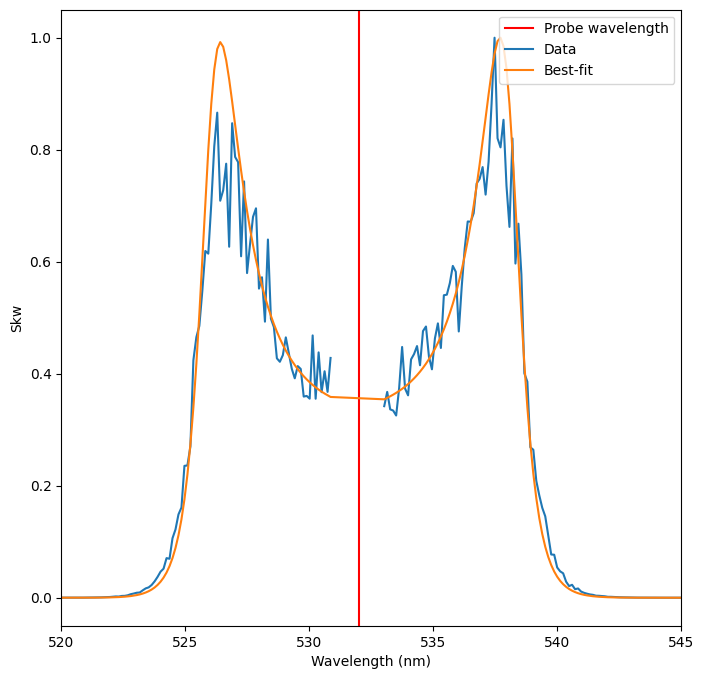
The resulting fit is very good, even though many of the ion parameters are still pretty far from their actual values!
Fitting the IAW Feature
We will now follow the same steps to fit the IAW feature. We’ll start by setting up a new lmfit.Parameters object, this time using the best-fit values from the EPW fit as fixed values for those parameters.
[12]:
settings = {}
settings["probe_wavelength"] = probe_wavelength.to(u.m).value
settings["probe_vec"] = probe_vec
settings["scatter_vec"] = scatter_vec
settings["ions"] = ions
settings["ion_vdir"] = np.array([[1, 0, 0], [1, 0, 0]])
params = Parameters()
params.add("n", value=n_fit, vary=False)
params.add("T_e_0", value=Te_0_fit, vary=False)
params.add("T_i_0", value=10, vary=True, min=5, max=60)
params.add("T_i_1", value=10, vary=True, min=5, max=60)
params.add("ifract_0", value=0.5, vary=True, min=0.2, max=0.8)
params.add("ifract_1", value=0.5, vary=True, min=0.2, max=0.8, expr="1.0 - ifract_0")
params.add("ion_speed_0", value=0, vary=False)
params.add("ion_speed_1", value=0, vary=True, min=0, max=1e6)
Now we will run the fit
[13]:
iaw_model = thomson.spectral_density_model(
iaw_wavelengths.to(u.m).value, settings, params
)
iaw_result = iaw_model.fit(
iaw_skw,
params=params,
wavelengths=iaw_wavelengths.to(u.m).value,
method="differential_evolution",
)
# Print some of the results compared to the true values
answers = {
"T_i_0": 20,
"T_i_1": 50,
"ifract_0": 0.3,
"ifract_1": 0.7,
"ion_speed_1": 2e5,
}
for key, ans in answers.items():
print(f"{key}: {iaw_result.best_values[key]:.1f} (true value {ans:.1f})")
print(f"Number of fit iterations:{iaw_result.nfev:.1f}")
print(f"Reduced Chisquared:{iaw_result.redchi:.4f}")
T_i_0: 19.8 (true value 20.0)
T_i_1: 51.1 (true value 50.0)
ifract_0: 0.3 (true value 0.3)
ifract_1: 0.7 (true value 0.7)
ion_speed_1: 199198.7 (true value 200000.0)
Number of fit iterations:1280.0
Reduced Chisquared:0.0004
And plot the results
[14]:
# Extract the best fit curve
best_fit_skw = iaw_result.best_fit
# Plot
fig, ax = plt.subplots(ncols=1, figsize=(8, 8))
ax.set_xlabel("Wavelength (nm)")
ax.set_ylabel("Skw")
ax.axvline(x=probe_wavelength.value, color="red", label="Probe wavelength")
ax.set_xlim(531, 533)
ax.plot(iaw_wavelengths.value, iaw_skw, label="Data")
ax.plot(iaw_wavelengths.value, best_fit_skw, label="Best-fit")
ax.legend(loc="upper right");
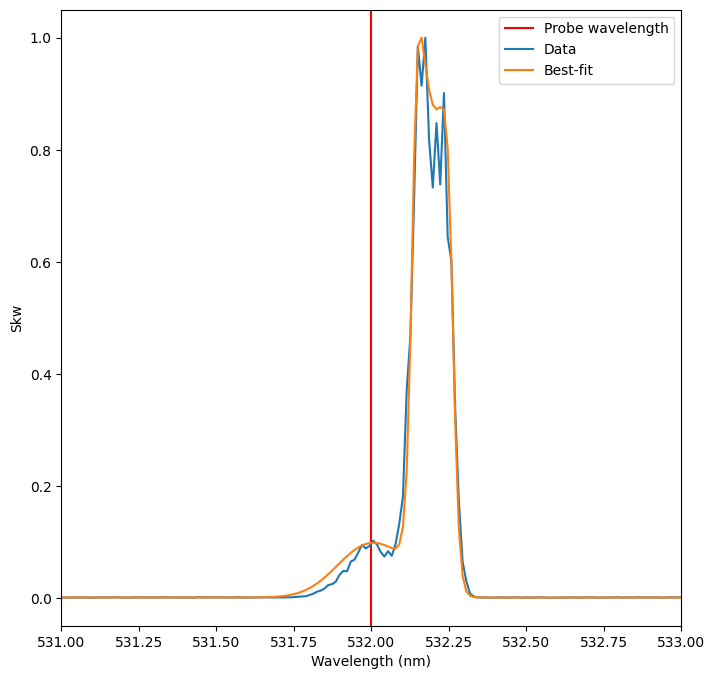
At this point, the best-fit parameters from the IAW fit could be used to further refine the EPW fit, and so on iteratively until both fits become stable.
Fitting Non-Collective Thomson Scattering
The non-collective Thomson scattering spectrum depends only on the electron density and temperature. In this regime the spectrum is less featured and, consequently, fits will produce larger errors. Otherwise, the fitting procedure is the same.
To illustrate fitting in this regime, we’ll start by generating some test data
[15]:
nc_wavelengths = (
np.linspace(probe_wavelength.value - 50, probe_wavelength.value + 50, num=1000)
* u.nm
)
n = 5e15 * u.cm**-3
T_e = 5 * u.eV
T_i = np.array([1]) * u.eV
ions = ["H+"]
alpha, Skw = thomson.spectral_density(
nc_wavelengths,
probe_wavelength,
n,
T_e=T_e,
T_i=T_i,
ions=ions,
probe_vec=probe_vec,
scatter_vec=scatter_vec,
)
# Normalize and add noise
nc_skw = Skw.value
nc_skw *= 1 / np.nanmax(nc_skw)
nc_theory = np.copy(nc_skw)
nc_skw *= 1 + np.random.normal(loc=0, scale=0.1, size=nc_wavelengths.size)
# Plot again
fig, ax = plt.subplots(ncols=2, figsize=(12, 4))
fig.subplots_adjust(wspace=0.2)
for a in ax:
a.set_xlabel("Wavelength (nm)")
a.set_ylabel("Skw")
a.axvline(x=probe_wavelength.value, color="red", label="Probe wavelength")
ax[0].set_xlim(520, 545)
ax[0].set_title("Theoretical signal")
ax[0].plot(nc_wavelengths.value, nc_theory)
ax[0].legend()
ax[1].set_xlim(520, 545)
ax[1].set_title("With noise")
ax[1].plot(nc_wavelengths.value, nc_skw)
ax[1].legend();
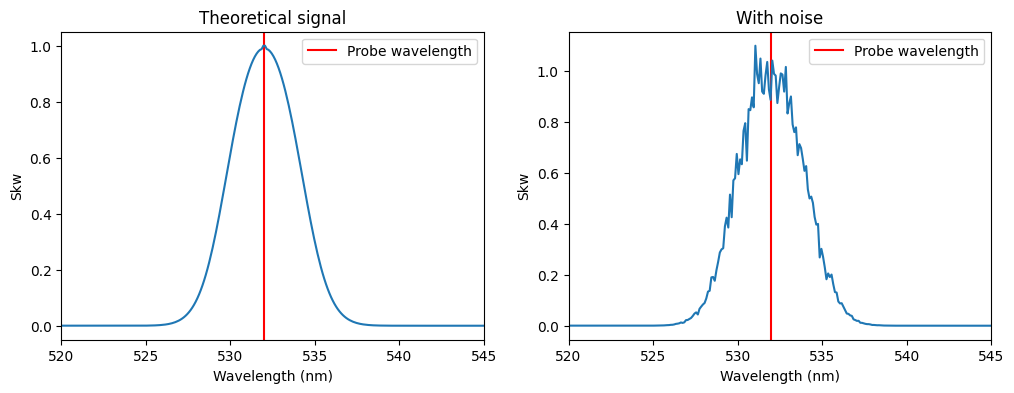
Then we will setup the settings dictionary and lmfit.Parameters object and run the fit.
Note that, in the non-collective regime, the spectral_density function is effectively independent of density. Just as in the collective-regime EPW fitting section, we still need to provide a value for n because it is a required argument for
spectral_density, but this parameter should be fixed and its value can be a rough approximation.
[16]:
settings = {}
settings["probe_wavelength"] = probe_wavelength.to(u.m).value
settings["probe_vec"] = probe_vec
settings["scatter_vec"] = scatter_vec
settings["ions"] = ions
params = Parameters()
params.add("n", value=1e15 * 1e6, vary=False) # Converting cm^-3 to m^-3
params.add("T_e_0", value=1, vary=True, min=0.1, max=20)
params.add("T_i_0", value=1, vary=False)
nc_model = thomson.spectral_density_model(
nc_wavelengths.to(u.m).value, settings, params
)
nc_result = nc_model.fit(
nc_skw,
params,
wavelengths=nc_wavelengths.to(u.m).value,
method="differential_evolution",
)
[17]:
best_fit_skw = nc_result.best_fit
print(f"T_e_0: {nc_result.best_values['T_e_0']:.1f} (true value 5)")
print(f"Number of fit iterations:{nc_result.nfev}")
print(f"Reduced Chisquared:{nc_result.redchi:.4f}")
# Plot
fig, ax = plt.subplots(ncols=1, figsize=(8, 8))
ax.set_xlabel("Wavelength (nm)")
ax.set_ylabel("Skw")
ax.axvline(x=probe_wavelength.value, color="red", label="Probe wavelength")
ax.set_xlim(520, 545)
ax.plot(nc_wavelengths.value, nc_skw, label="Data")
ax.plot(nc_wavelengths.value, best_fit_skw, label="Best-fit")
ax.legend(loc="upper right");
T_e_0: 5.8 (true value 5)
Number of fit iterations:113
Reduced Chisquared:0.0002
